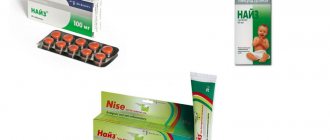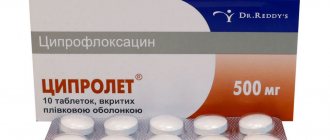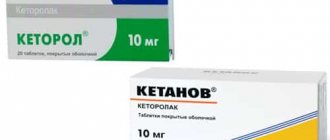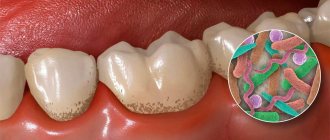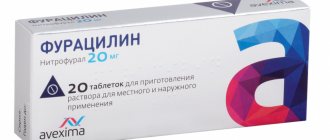Features of the composition of Doxycycline
The instructions indicate that the drug capsules include the following ingredients:
- doxycycline;
- milk sugar;
- magnesium salt of stearic acid;
- starch.
Cylindrical capsules are filled with a yellowish powdery mass with whitish inclusions. Each package contains 2 contour units, which contain 5 pieces of medicine.
Ampoules with a solution of 100 mg are packaged in boxes of 5 or 10 pieces.
Doxycycline, capsules
The drug is taken orally during or after meals with a glass of water. Capsules are taken while sitting or standing and well before bedtime to reduce the risk of irritation and ulceration of the esophagus. If signs of stomach irritation are observed, it is recommended that you take doxycycline with food or milk. The usual dose for the treatment of acute infections for adults and children over 12 years of age weighing more than 45 kg is on the first day 200 mg (2 capsules) in 1 or 2 doses, from the second day - 100 mg (1 capsule) 1 time per day. The maximum daily dose for severe infections is 200 mg/day in 1–2 doses (especially for chronic urinary tract infections).
The duration of treatment depends on the type of infection and is usually 5–10 days. For Lyme disease, the course of treatment is 3–4 weeks, for brucellosis – 1.5–6 months. Therapy should be continued for at least 24–48 hours after symptoms have resolved. In the case of streptococcal infection, the duration of therapy should be at least 10 days to prevent rheumatism or glomerulonephritis. Uncomplicated gonococcal infection in adults (except anorectal infection in men): 100 mg 2 times a day for 7 days. As an alternative: an initial dose of 300 mg, then an hour later a repeat dose of 300 mg.
Uncomplicated urethritis, endocervicitis, or rectal infection in adults caused by C. trachomatis: 100 mg twice daily for 7 days.
Non-gonococcal urethritis caused by C. trachomatis or U. urealyticum: 100 mg 2 times a day for 7 days. Early syphilis: 100 mg 2 times a day for 2 weeks (for non-pregnant patients with an allergy to penicillin).
Syphilis of more than one year's duration: 100 mg twice daily for 4 weeks (for non-pregnant patients allergic to penicillin). Acute epididymo-orchitis caused by N. gonorrhoeae or C. trachomatis: 100 mg 2 times daily for at least 10 days.
For the treatment of acne - 50 mg/day for 6–12 weeks.
Treatment of malaria caused by chloroquine-resistant P. falciparum: 200 mg/day for at least 7 days. Given the potential severity of the infection, a fast-acting schizonticidal drug such as quinine should be used concomitantly with doxycycline, the recommended dosage of which varies by region.
Prevention of malaria: 100 mg/day in adults; in children over 12 years of age, the drug is prescribed at a dose of 2 mg/kg 1 time per day; the dose can reach that for adults. Prophylaxis can be prescribed 1–2 days before travel to an area where malaria occurs. This should be continued throughout the trip and for 4 weeks after returning.
Prevention of Japanese river fever: 200 mg once orally. Prevention of travelers' diarrhea in adults: 200 mg on the first day of travel (once or 100 mg every 12 hours), and then 100 mg/day throughout your stay in the region. There is no information on the prophylactic use of the drug for more than 21 days.
Prevention of leptospirosis: 200 mg orally once a week throughout your stay in the region and 200 mg at the end of the trip. There is no information on the prophylactic use of the drug for more than 21 days. Pulmonary anthrax (after exposure): adults, 100 mg orally 2 times a day for 60 days. Children weighing less than 45 kg: 2.2 mg/kg orally 2 times a day for 60 days. In children weighing more than 45 kg, doxycycline is used at the usual dose for adults.
For tick-borne and louse-borne relapsing fever, doxycycline was successfully used in a single dose of 100 mg or 200 mg, depending on the severity of the infection. In order to reduce the risk of persistence or recurrence of tick-borne relapsing fever, it is recommended to use doxycycline 100 mg every 12 hours for 7 days.
Elderly patients: no dose adjustment is required.
Hepatic impairment: Doxycycline should be used with caution in patients with hepatic impairment or in individuals receiving potentially hepatotoxic drugs. Renal Impairment: Studies have shown that the use of doxycycline at usual recommended doses does not result in excessive accumulation of the antibiotic in patients with renal impairment.
In the presence of renal failure, no dose adjustment is required.
Indications for Doxycycline and contraindications
The abstract recommends prescribing the medication for certain infections:
- for bronchitis (with acute or recurrent course), tracheitis, pharyngitis;
- lung abscesses, pneumonia, sore throat, inflammation of the middle ear, bile ducts;
- dysentery with bacterial etiology;
- cholecystitis, gastroenterocolitis;
- felon, abscess, phlegmon, furunculosis;
- pyelonephritis, ureaplasma, urethritis;
- prostatitis, endometritis, gonorrhea;
- acute intestinal infections;
- legionellosis, Lyme disease, etc.
When included in combination therapy, Doxycycline is used to treat whooping cough, leptospirosis, trachoma, sepsis, peritonitis and other pathological processes. The drug can be prescribed for the prevention of purulent complications after surgical interventions and medical abortions.
Doxycycline is contraindicated in patients:
- with intolerance to the component composition;
- severe liver failure;
- porphyria.
The medicine is prohibited for children under 8 years of age, pregnant and lactating women.
Doxycycline solution tablets, 10 pcs., 100 mg, dispersible tablets
Inside.
The tablets are dissolved in a small amount of water (about 20 ml) to obtain a suspension; the tablets can also be swallowed whole, divided into pieces or chewed with water. Preferably taken with food. Take the tablets while sitting or standing, which reduces the likelihood of developing esophagitis or esophageal ulcers. The drug should not be taken immediately before bedtime.
Usually the duration of treatment is 5-10 days.
Adults and children over 8 years old weighing more than 50 kg
200 mg in 1-2 doses on the first day of treatment, then 100 mg daily. In cases of severe infections, the drug is prescribed at a dose of 200 mg daily during the entire course of treatment.
Children 8-12 years old weighing less than 50 kg
The average daily dose is 4 mg/kg on the first day, then 2 mg/kg per day (in 1-2 doses). In cases of severe infection, the drug is used at a dose of 4 mg/kg daily throughout the course of treatment.
Features of dosing for certain diseases
For infection caused by S.pyogenes, the drug is taken for at least 10 days.
For uncomplicated gonorrhea (excluding anorectal infections in men):
Adults - 100 mg 2 times a day until complete cure (on average within 7 days), or 600 mg - 300 mg in 2 doses are prescribed for one day (the second dose is 1 hour after the first).
For primary syphilis - 100 mg 2 times a day for 14 days, for secondary syphilis - 100 mg 2 times a day for 28 days.
For uncomplicated urogenital infections caused by Chlamydia trachomatis, cervicitis, non-gonococcal urethritis caused by Ureaplasma urealiticum - 100 mg 2 times a day for 7 days.
For acne - 100 mg 1 time per day, course of treatment is 6-12 weeks.
Malaria (prevention): 100 mg 1 time per day 2 days before the trip, then daily during the trip and for 4 weeks after return; children over 8 years old - 2 mg/kg 1 time per day.
Travelers' diarrhea (prevention) - 200 mg on the first day of the trip in 1 or 2 doses, then 100 mg 1 time per day during the entire stay in the region (no more than 3 weeks).
Treatment of leptospirosis - 100 mg orally 2 times a day for 7 days; prevention of leptospirosis - 200 mg once a week during your stay in a disadvantaged area and 200 mg at the end of the trip.
To prevent infections during medical abortion - 100 mg 1 hour before and 200 mg after the intervention.
Maximum daily doses for adults are up to 300 mg/day or up to 600 mg/day for 5 days for severe gonococcal infections. For children over 8 years old weighing more than 50 kg - up to 200 mg, for children 8-12 years old weighing less than 50 kg - 4 mg/kg daily throughout treatment.
In the presence of renal failure (creatinine clearance less than 60 ml/min) and/or liver failure, a reduction in the daily dose of doxycycline is required, since it gradually accumulates in the body (risk of hepatotoxicity).
Adverse reactions
The instructions mention registered non-standard responses to therapeutic procedures. Doxycycline can cause:
- increased intracranial pressure with attacks of dizziness, vomiting, headaches, loss of appetite, swelling of the optic nerves;
- extraneous tinnitus, anorexia due to metabolic dysfunction;
- decreased visual acuity, diplopia, scotoma;
- dermatological rash, obsessive itching, redness;
- nettle fever, Quincke's edema, anaphylaxis;
- dyspeptic disorders, gastroduodenitis, glossitis, enterocolitis;
- decreased blood pressure, pericarditis, rapid heartbeat, erythema multiforme;
- liver dysfunction, muscle, joint pain;
- hepatitis of autoimmune etiology, candidiasis;
- dysbacteriosis, inflammation of the anogenital area, changes in the shade of tooth enamel.
The drug causes toxic epidermal necrolysis and photosensitivity.
The nuances of Doxycycline therapy
Capsules are taken after meals with sufficient water. This approach reduces the likelihood of irritation in the gastrointestinal tract. The daily dosage of Doxycycline is divided into two procedures, maintaining a twelve-hour interval.
Pathologies are treated according to a single scheme:
- first day – 0.2 g of the drug;
- subsequent days - from 0.1 to 0.2 g;
- for complex forms – 0.2 g daily.
Therapeutic procedures depend on the type of disease:
- Diseases caused by chlamydia, mycoplasma or ureaplasma require a standard treatment regimen. The drug is prescribed for a period of 10-14 days.
- Acute inflammation in the pelvis requires taking Doxycycline 0.1 g in the morning and evening. For men, the medication is prescribed 0.3 g once or 0.1 g in the morning and evening.
- Children over 8 years old are given 4 mg per kilogram of weight in the first 24 hours, then the dose is reduced to 2 mg/kg per day.
- To prevent complications of infection during medical abortions, the patient is prescribed 0.1 g of medication 60 minutes before the procedure and 0.2 g half an hour after its completion.
- Primary secondary syphilis - 0.3 g per day, for 10 days. For gonorrhea - 100 mg in the morning and evening, up to 4 days in a row.
- Gonorrheal urethritis - with a persistent pathogen, 0.2 g for 4-5 days. A mild form of pathology is suppressed with a single dose of 0.3 g.
- Acne - 0.05 g daily. Treatment takes 1.5-4 months according to an individual regimen prescribed by the attending physician.
- Tick bite - dosages are prescribed by a specialist; to prevent infection, the drug should be used no later than three days after the insect attack.
- Borreliosis - 0.2 g per day, therapy ends after 5 days.
An intravenous solution is administered every 12 hours; cephalosporins (3rd generation) are added to therapy. The manipulation lasts up to 2 hours; before it begins, water for injections is added to 0.1 g of Doxycycline - 10 ml. The prepared product is diluted in 1 liter of physiological solution.
Doxycycline
Doxycycline
(eng.
doxycycline
) is a semi-synthetic antibiotic of wide use, a derivative of tetracycline. In gastroenterology, it is considered as a drug that can cause inflammation of the mucous membrane of the upper gastrointestinal tract and thus provoke the development of esophagitis, ulcers of the esophagus, stomach and duodenum.
Doxycycline is a chemical
Chemically, doxycycline is [4S-(4alpha,4a alpha,5alpha,5a alpha,6alpha,12a alpha)]-4-(Dimethylamino)-1,4,4a,5,5a,6,11,12a-octahydro-3 ,5,10,12,12a-pentahydroxy-6-methyl-1,11-dioxo-2-naphthacenecarboxamide. The empirical formula for doxycycline is C22H24N2O8. The molecular weight of doxycycline is 444.435 g/mol. Doxycycline, as a chemical, appears as a light yellow crystalline powder.
Doxycycline - medicine
Doxycycline is the international nonproprietary name (INN) of the drug. According to the pharmacological index, doxycycline belongs to the “Tetracyclines” group. According to ATC, doxycycline is included (or was previously included) in a number of groups and is assigned different codes, in particular:
- "A01 Dental preparations", code A01AB22
- "J01 Antibacterial drugs for systemic use", code J01AA02
In medications, doxycycline is used in the form of hydrochloride, monohydrate or hyclate.
Microorganisms against which doxycycline is or is not active
Doxycycline is active against:
- gram-negative bacteria: Neisseria gonorrhoeae, Calymmatobacterium granulomatis, Haemophilus ducreyi, Haemophilus influenzae, Yersinia pestis, Francisella tularensis, Vibrio cholerae, Bartonella bacilliformis, Brucella specie, Campylobacter fetus
- and also: Escherichia coli, Klebsiella spp., Shigella spp., Acinetobacter spp., Bacteroides spp., Helicobacter pylori
; taking into account that many strains of these groups of bacteria are resistant to tetracyclines, therefore, before using doxycycline, testing its effectiveness is required
,
Propionibacterium acnes,
alpha-hemolytic streptococci
.
Pseudomonas aeruginosa, Proteus spp., Serratia spp.
are resistant to doxycycline , most strains of
Bacteroides fragilis
.
Indications for the use of doxycycline
Doxycycline is indicated for infections caused by microorganisms sensitive to it:
- respiratory tract infections caused by Mycoplasma pneumoniae, Chlamydia pneumoniae, Chlamydia psittaci.
For infections of the respiratory tract and ENT organs caused by
Haemophilus influenzae, Klebsiella spp., Streptococcus pneumoniae,
doxycycline is used as an alternative drug in patients with hypersensitivity to penicillin; - infections of the genitourinary system caused by Chlamydia trachomatis, Ureоplasma urealitycum
- conjunctivitis caused by Chlamydia trachomatis
- typhus, ehrlichiosis, Rocky Mountain fever, Q fever, trench fever and other infections caused by Rickettsia spp.
- sexually transmitted infections in patients with hypersensitivity to penicillins: gonorrhea - caused by Neisseria gonorrhoeae
and syphilis - caused by
Treponema pallidum,
chancroid - caused by
Haemophilus ducreуi - cholera is caused by Vibrio comma
- early stages of Lyme disease with skin manifestations (erythema migrans annulare, benign cutaneous lymphoma)
- inguinal granuloma caused by Calymmatobacterium granulomatis
- trachoma—causative agent Chlamydia trachomatis
- psittacosis - causative agent Chlamydia psittaci
- Brucellosis is caused by Brucella spp
. in combination with streptomycin; - bortonellosis caused by Bartonella bacilliformis
- plague - causative agent Yersinia pestis
- tularemia caused by Francisella tularensis
- infections caused by Campylobacter fetus
- prevention of malaria caused by Plasmodium falciparum
during a stay of up to four months in an area where Plasmodium resistance to chloroquine and/or pyrimethamine-sulfadoxine has been noted
The role of doxycycline in the development of gastroesophageal reflux disease
If there is inflammation of the esophageal mucosa, it is necessary to limit the intake of doxycycline. Different authors emphasize different ways in which doxycycline may have a negative effect on the esophagus:
- doxycycline can reduce the tone of the lower esophageal sphincter (Maev I.V. et al., Sayfutdinov R.G., Trifonova E.V.)
- doxycycline can irritate or directly damage the mucous membrane of the esophagus (Bueverov A.O., Rapoport S.I. et al., Masharova A.A., Kim V.A.)
Taking doxycycline is one of the most common causes of drug-induced damage to the esophagus and the development of esophagitis in young patients (Tkach S.M., Kuzenko Yu.G.).
To prevent irritation to the mucous membrane of the esophagus and stomach, it is recommended to take doxycycline during the day with plenty of liquid, food or milk.
Doxycycline and gastric and duodenal ulcers
Doxycycline has been used to treat gastric and duodenal ulcers associated with Helicobacter pylori
since the 1990s.
In particular, it was recommended as part of a four-component regimen for the second line
of eradication of
Helicobacter pyrori
: doxycycline 200 mg 2 times a day + proton pump inhibitor in a standard dose + tripotassium bismuth dicitrate 120 mg 4 times a day + furazolidone 100 mg 4 times a day for 7 days.
Recently, in different countries, Helicobacter pyrori
to doxycycline has reached 33.3% and continues to increase annually (Y. S. Zimmerman).
In the work of Nizhevich A.A. eradication of Helicobacter pyrori
in children, when using the regimen doxycycline (200 mg/day) + omeprazole (1 mg/kg/day) + bismuth tripotassium dicitrate (8 mg/kg/day) + furazolidone (20 mg/kg/day) reaches 86.7%.
Maastricht IV does not recommend the use of doxycycline instead of tetracycline hydrochloride in Helicobacter pyrori
(Isakov V.A.).
Currently, doxycycline is considered as one of the ulcerogenic drugs that can cause the formation of gastroduodenal ulcers. Patients taking ulcerogenic drugs are at very high risk of developing gastrointestinal bleeding. Doctors should be wary of the possibility of complications during treatment with ulcerogenic drugs and instruct patients about the rules for taking them and contraindications to them (Agapova N.G.). To reduce the ulcerogenic effect, it is recommended to take doxycycline during the day with plenty of liquid or food.
Side effects of doxycycline
In addition to the above effects on the upper gastrointestinal mucosa, doxycycline can cause vomiting, nausea, abdominal pain, constipation, diarrhea, anorexia, headache, papilledema, vision changes, dizziness, hemolytic anemia, thrombocytopenia, eosinophilia , neutropenia, decreased prothrombin activity.
Professional medical publications addressing the use of doxycycline in gastroenterology
- Agapova N.G. About drug-induced gastroduodenal ulcers // Journal “Mystery of Likuvannya”. Ukraine. – 2007. – 2(38).
- Nizhevich A.A. Clinical and morphological characteristics, genetic markers, diagnosis and treatment of HP-associated gastroduodenal diseases in children. Abstract of dissertation. Doctor of Medical Sciences, 01/14/08 - pediatrics, 01/14/28 - gastroenterology. BSMU, Moscow, 2010
- Pfizer Labs instructions for the USA (in English, pdf): Vibramycin Calcium (doxycycline calcium oral suspension, USP), oral suspension, Syrup. Vibramycin Hyclate (doxycycline hyclate capsules, USP), Capsules. Vibramycin Monohydrate (doxycycline monohydrate) for oral suspension. Vibra-Tabs (doxycycline hyclate tablets, USP), film coated tablets.
On the website in the literature catalog there is a section “NSAIDs and other drug-induced gastropathy”, containing articles on gastrointestinal diseases caused by the use of various drugs.
Use of doxycycline during pregnancy, breastfeeding and children
Dixocycline is contraindicated during pregnancy and breastfeeding.
Dixocycline penetrates the placental barrier. The FDA Fetal Action Category for dixocycline is D (there is evidence of a risk of adverse effects of the drug on the human fetus, but the potential benefit associated with the use of the drug in pregnant women may justify its use despite the risk).
Doxycycline is not used in children under 8 years of age, as it causes long-term discoloration of teeth, enamel hypoplasia, and slower longitudinal growth of skeletal bones.
Trade names of drugs containing the active ingredient doxycycline
The following drugs with the only active ingredient doxycycline are registered (were previously registered) in Russia: Bassado, Vibramycin, Vidoccin, Dovicin, Doxal, Doxibene, Doxibene M, Doxylan, Doxycycline, Doxycycline Nycomed, Doxycycline Stada, Doxycycline-AKOS, Doxycycline-Ferein, Doxycycline hydrochloride, Doxycycline hydrochloride capsules, Xedocin, Monoclin, Unidox Solutab.
Brands of doxycycline in the USA are Adoxa, Alodox, Avidoxy, Doryx, Monodox, Morgidox, Ocudox, Oracea, Oraxyl, Vibramycin.
general information
Doxycycline is a prescription drug in both Russia and the USA.
Doxycycline has contraindications, side effects and application features; consultation with a specialist is necessary.
Back to section

